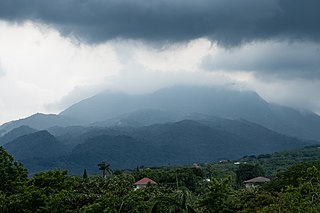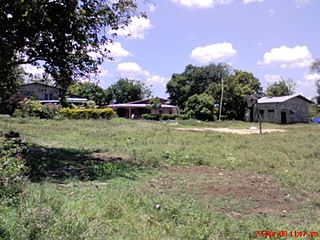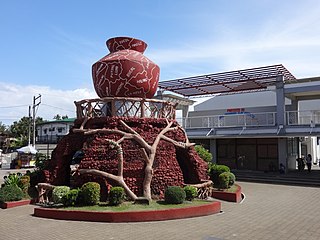
Laguna, officially the Province of Laguna, is a province in the Philippines located in the Calabarzon region in Luzon. Its capital is Santa Cruz while its largest city is the City of Calamba and the province is situated southeast of Metro Manila, south of the province of Rizal, west of Quezon, north of Batangas and east of Cavite. Laguna hugs the southern shores of Laguna de Bay, the largest lake in the country. As of the 2020 census, the total population of Laguna is 3,382,193. Among all 82 provinces in the Philippines, Laguna accounted for the largest share (5%) of the national Gross Domestic Product (GDP) with a total of Php 990.69 billion in 2022.

Calabarzon, sometimes referred to as Southern Tagalog and designated as Region IV‑A, is an administrative region in the Philippines. It is situated southeast of Metro Manila and is bordered by Manila Bay and the South China Sea to the west, Lamon Bay and the Bicol Region to the east, Tayabas Bay and the Sibuyan Sea to the south, and Central Luzon to the north. Comprising five provinces—Cavite, Laguna, Batangas, Rizal, and Quezon —and one highly urbanized city, Lucena, it is the most populous region in the Philippines, according to the 2020 census (PSA), with over 16.1 million inhabitants. It is also the country's second most densely populated region, after the National Capital Region. Calamba in Laguna serves as the regional center, while Antipolo in Rizal is the most populous city in the region.

San Pablo, officially the City of San Pablo, is a component city in the province of Laguna, Philippines. According to the 2020 census, it has a population of 285,348 people.

Los Baños, officially the Municipality of Los Baños, colloquialy 'elbi' or simply LB, is a municipality in the province of Laguna, Philippines. According to the 2020 census, it has a population of 115,353 people.

Calamba, officially the City of Calamba, is a component city in the province of Laguna, Philippines. According to the 2020 census, it has a population of 539,671 people making it the largest city in the province.

Biñan, officially the City of Biñan, is a component city in the province of Laguna, Philippines. According to the 2020 census, it has a population of 407,437, making it the third largest in population in the province of Laguna, after Calamba and Santa Rosa.

Cabuyao, officially the City of Cabuyao, is a component city in the province of Laguna, Philippines. According to the 2020 census, it has a population of 355,330 people.

Canlubang is a major industrial zone located in the province of Laguna, Philippines. It was once a hacienda during the Spanish colonial period. Canlubang straddles two component cities of Laguna: Cabuyao, Calamba, the municipality of Silang in Cavite, and the city of Tagaytay.

The legislative districts of Laguna are the representations of the province of Laguna in the various national legislatures of the Philippines. The province is currently represented in the lower house of the Congress of the Philippines through its first, second, third, and fourth congressional districts.

Kay-Anlog is a component barangay of the city in Calamba, Laguna, Philippines, situated in the southern part of the city, adjacent to the barangays of Milagrosa, Burol, Bubuyan, and Ulango.

The San Cristobal River, commonly known as the Matang Tubig River, is a river system in the cities of Calamba and Cabuyao, Laguna, Philippines. The river is one of 21 major tributaries of Laguna de Bay.

Calamba station is a railway station located on the South Main Line in Laguna, Philippines. It is one of two railway stations in the city and it is a major station on the line, serving as the junction between the South Main Line and the old Calamba–Batangas branch line which used to connect to Batangas City. It is also envisioned to be the terminus of the Commuter Express when rehabilitation work is complete. The station was first opened on January 24, 1909.

Real is a barangay in the city of Calamba. It is also where the new Calamba City Hall and the Rizal Monument are located.

The Rizal Shrine in Calamba is a reproduction of the original two-story, Spanish-colonial style house in Calamba, Laguna where José Rizal was born on June 19, 1861. Rizal is regarded as one of the greatest national heroes of the Philippines.

Saint John the Baptist Parish Church, commonly known as Calamba Church, is the oldest Roman Catholic church in Calamba, Laguna, Philippines under the Diocese of San Pablo. It is located adjacent to Rizal Shrine and is known as the christening site of José Rizal.

The Calamba Claypot, also known as the Calamba Jar and the Banga, is a landmark in Calamba, Laguna, Philippines, considered the largest claypot in the world. It is located at the City Plaza near Calamba Church and Rizal Shrine. Built in 1937, it was constructed to reference the origin of the town's name with names of the cities and villages inscribed on its exterior. The giant claypot can also be found in the city's official seal.

The Rizal Monument in Calamba is a monument built to commemorate the sesquicentennial (150th) birth anniversary of Dr. José Rizal, the Philippines' unofficial national hero and the greatest son of Calamba. It is a 6.7 metres (22 ft) statue sculpted by Jonas Roces and is located at The Plaza, a 6.7-hectare (17-acre) park in front of the Calamba City Hall Complex along Bacnotan Road in the barangay of Real. President Benigno Aquino III led the unveiling of the monument on June 19, 2011. The monument was cited as the tallest Rizal monument in the world before former Laguna Governor Jeorge 'E.R.' Ejercito Estregan inaugurated a 26 feet bronze Rizal Monument sculpted by Toym Imao, son of National Artist for Sculpture Abdulmari Asia Imao in Santa Cruz, Laguna, for the 2014 Palarong Pambansa hosted by the province.

Emilio Ramon Pelayo Ejercito III, commonly known as E. R. Ejercito, is a Filipino actor and former governor of Laguna from 2010 until his removal in 2014. Prior to his election as governor, he served as mayor of Pagsanjan, Laguna, from 2001 until 2010. He is the son of actor George Estregan and the nephew of former President and former Manila Mayor Joseph Estrada.
The legislative district of Calamba are the representations of the component city of Calamba in the Congress of the Philippines. The city is currently represented in the lower house of the Congress through its lone congressional district.




















